In recent years, the landscape of global trade and retail has experienced an unparalleled evolution. Among the fastest-growing sectors is ecommerce, sparking an entrepreneurial wave and empowering small to medium-sized enterprises in large-scale manufacturing. This shift is driven by a monumental move from traditional brick-and-mortar setups to the realm of online shopping, all thanks to the rise of internet-based purchasing platforms, known as ‘ecommerce websites’.
The rise of ecommerce has dismantled barriers, fostering deeper interactions between customers and manufacturers. It has brought forth a wave of accessibility through user-friendly mobile apps and sophisticated digital storefronts. These virtual marketplaces, housed within ecommerce platforms, have been instrumental in nurturing the growth of myriad businesses, subsequently bolstering employment opportunities.
Projections indicate that by 2024, ecommerce will represent a staggering 26% of global retail sales, amounting to over $7.2 trillion in transactions. Embracing these leading ecommerce platforms presents an enticing proposition for businesses aiming to enhance sales and streamline expenses. It’s an avenue for sellers to expand their reach across domestic and international markets, tapping into a broader clientele base.
So, which online shopping platform is the best for retailers to invest in? With the usage of smartphones, today’s technology has improved quickly, making internet purchasing for consumers a seamless process.
What are ecommerce websites?
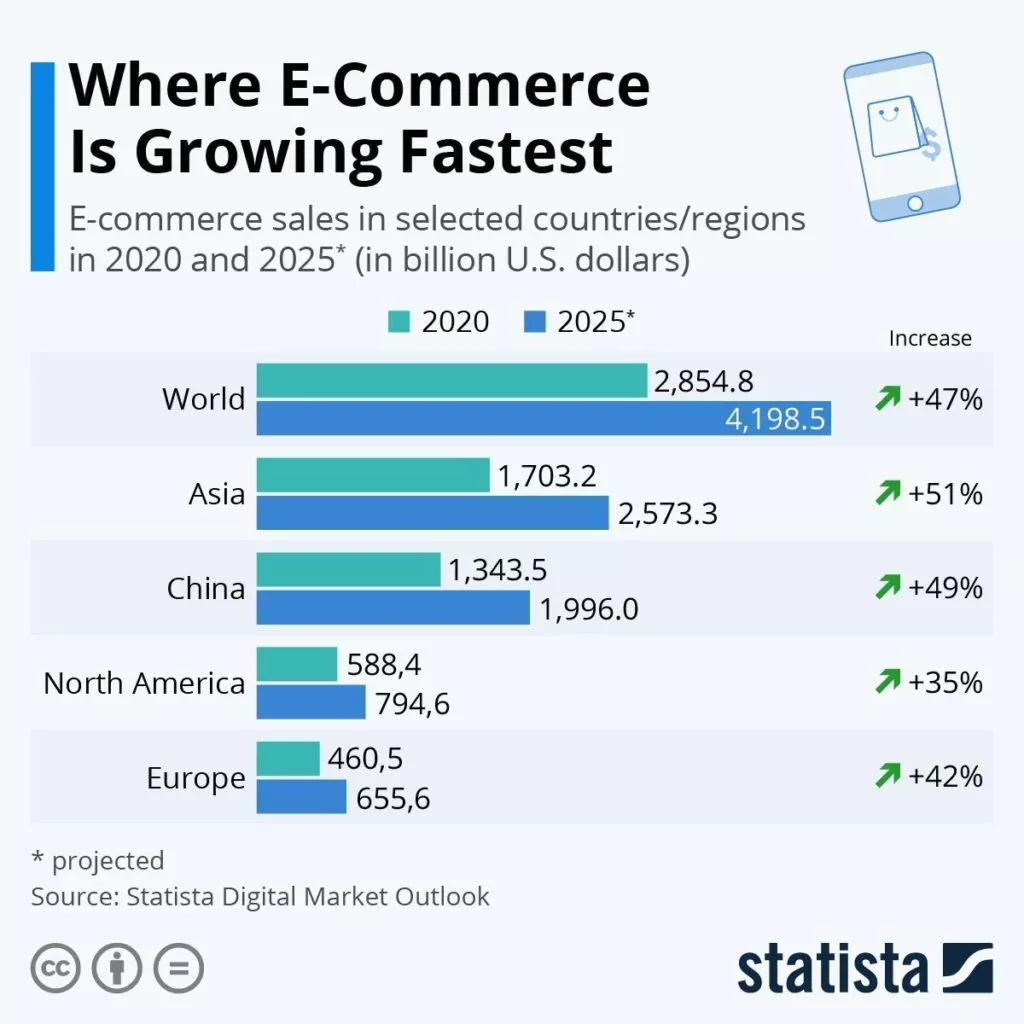
By definition, an eCommerce website enables you to purchase and sell physical goods, digital products, or services online. It’s a business concept that incorporates online sales transactions, and this format is followed by almost every online shopping website, large or small.
ECommerce websites are places where you can make purchases over the internet.
Factors that Determine the Success of Ecommerce Website:
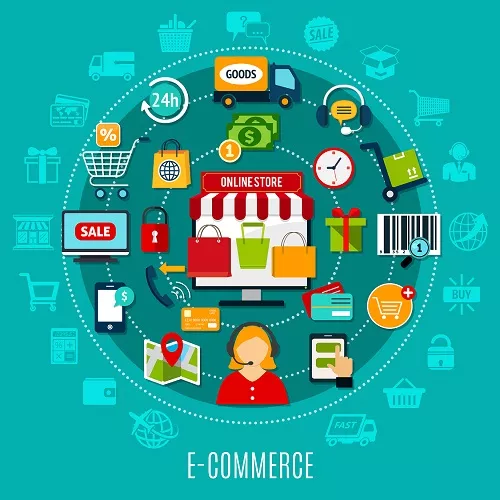
- Responsive Design
Over half of all web traffic worldwide comes from mobile devices (excluding tablets) (Statista, 202). No matter what device consumers use to access your site, you want to make buying as simple as possible for them. You can lose out on many sales if your eCommerce site isn’t mobile-optimized. It’s crucial to have a responsive eCommerce site that looks beautiful on all types of devices if you want to make it easier for customers to purchase from your store. Choosing the appropriate theme can make building a responsive eCommerce site simple because most eCommerce systems come with mobile-optimized articles.
- Visually Appealing Design
Although it’s doubtful that your eCommerce website design will appeal to every person who visits it, there are still several things you can do to improve the aesthetic appeal of your site. Keep in mind that your eCommerce website serves as your first impression.
- Product Pictures: Customers that visit your eCommerce store use the product photos to decide whether or not to make a purchase. The use of attractive and high-quality product photos is crucial for this reason.
- Images of the product in use are crucial because you want potential customers to be able to envision themselves using your product. Having a role model in mind makes this much simpler.
- Colors and fonts: These elements of your website’s design are equally crucial. Everyone has seen a website that appears to have been around since the early 1990s. Please don’t do it unless that’s your schtick.
- Keep your eCommerce website design clean and minimal, using no more than two colors. Additionally, you should pick two complementary fonts—one for headings and one for body copy. You can stay with a single typeface to keep things even simpler.
- Accessibility
Another crucial component of an attractive and well-designed website is accessibility. From the QA and UAT testing business StarDust, here are ten great suggestions for improving accessibility:
- Utilize an accessible content management system (CMS).
- Use headers to divide up your material
- Give your photos alt-text tags
- Use tables for tabular data, descriptive titles in link titles, high contrast colors, property label text fields when designing forms for accessibility, keyboard navigation, closed captions, and text alternatives for dynamic content like embedded videos and GIFs, and accessibility testing to verify your site’s accessibility.
- Easy-to-Use Navigation: The navigation of your website consists of the main menu, the on-site search bar, the filters, the product category pages, and the content of your footer.
- Because the goal of navigation is to make it simple for customers to find what they’re looking for, your navigation flow should be as condensed as possible, minimizing the number of paths a user must take.
- Bonus: Because search engines can better crawl your site with well-designed navigation, it will help with SEO and make it easier for customers to find what they want.
- Outstanding user experience:
Everything we’ve just covered is part of user experience (UX), but it goes a little farther than that. Design thinking, an iterative process used to learn the activities users take on an app or website, is a technique used by UI/UX specialists.
The finest UI/UX designers employ the following six digital design thinking best practices to make the best eCommerce sites:
- Give users navigational cues to help them navigate your site.
- Provide feedback to let visitors know what’s happening (like a confirmation page or email after taking a certain action.)
- Include thoughtful automation to reduce friction
- Make an emotional appeal
Create a smooth user journey that keeps visitors engaged
- Trust Signals
How do you tell if the website you’re reading is trustworthy? When making an online purchase, you most likely use a credit card or a payment method like PayPal that is directly linked to your bank account.
Although you can contest bogus accusations, is it preferable to stay out of that situation altogether?Most customers seek trust indicators to determine whether they can trust your website with their sensitive personal data.
There are some easy things you can do to calm their fears:
- Include contact details like a mailing address, email address, and phone number.
- Provide a return policy.
- Proudly display your compliance and security technology badges.
- Share client testimonials, reviews, and other forms of social proof.
The following qualities are the most important ones to consider when choosing among the many options.
- Serviceability/Pin Code Reach
This is the most crucial consideration when choosing an eCommerce company to shop with. The top people are, without a doubt, those who ship or deliver to your specified locations. An eCommerce business with a wider reach will probably ship to most places, so you won’t have to worry about looking for alternatives if you move or need to send something to a loved one.
- Goods and Services
Each eCommerce company and platform provides a unique selection of goods and services. The ideal eCommerce platform eliminates the need to navigate between apps by offering a wide range of services and advantages in one location. Some of these platforms also offer services for creating online stores.
- Delivery Mechanisms
The term “delivery mechanisms” refers to the entire system, including storage, transportation, and communication, that every eCommerce company uses for routine deliveries Miscommunications between an online marketplace for trade, and its users can be a significant source of unhappiness It’s critical to determine whether the business or platform can deliver a range of products securely and reliably. Waiting for a defective product wouldn’t be a good idea!
- Delivery Time
In today’s market, quick shipment is crucial. Over 3-5 days, they start to get anxious. Fast-track deliveries from an online retailer to ensure happy customers and fewer cancellations. Verify the anticipated delivery date before selecting the best choice for you.
- Tracking Visibility
Order tracking visibility is essential for the consumer to have a great post-purchase experience. To track orders more openly, the eCommerce company must offer real-time order tracking with automatic periodical updates. Every stage of delivery must be communicated to the customer.
- Delivery Proof
Not all deliveries are successful. The greatest eCommerce business will have a clear strategy and mechanism for sending proof of delivery, allowing for the documentation of customer complaints and holding delivery workers accountable for the product’s state at the time of delivery.
- Returns Administration
It’s only sometimes guaranteed that you’ll enjoy the items you get; some are intended for testing, while others may need to be revised. In these situations, the ideal eCommerce company has a strong returns management system, where a pick-up time is set, and the company ensures the package follows its original path back to the business.
World’s Best Ecommerce Websites of 2024:
1. Amazon

Amazon emerged in 1994 as a modest online bookstore, focusing solely on selling books. Founded by Jeff Bezos, the platform swiftly expanded its horizons and diversified its offerings beyond literature. Fast forward to today, Amazon has evolved into a colossal e-commerce behemoth that virtually revolutionized online shopping. Its global influence spans across numerous countries, attracting nearly 3 billion visitors monthly to its digital storefronts.
Over time, Amazon diversified its inventory, branching out from books into a myriad of categories. From electronics and fashion to sporting goods and streaming services, the platform has become a one-stop-shop for a vast array of products. This diversification strategy helped propel Amazon’s growth exponentially, enabling it to capture a significant market share in various industries.
Amazon’s net worth soared to an awe-inspiring valuation of over $1.7 trillion USD. This staggering figure highlights the company’s unparalleled success and market dominance, fueled by its innovative approaches, strategic acquisitions, and relentless customer focus.
One of Amazon’s notable services, Amazon Prime, has reshaped the landscape of online shopping. This subscription-based program not only provides access to a wide array of entertainment options through Prime Video and Prime Music but also offers premium perks like expedited shipping. U.S. customers enrolled in Amazon Prime benefit from complimentary one or two-day shipping, elevating the convenience and satisfaction of their shopping experience.
Through continuous innovation, a customer-centric approach, and relentless expansion into new markets and services, Amazon has solidified its status as a trailblazer in the e-commerce industry, redefining the way people shop and consume goods and services globally.
2. Craiglist
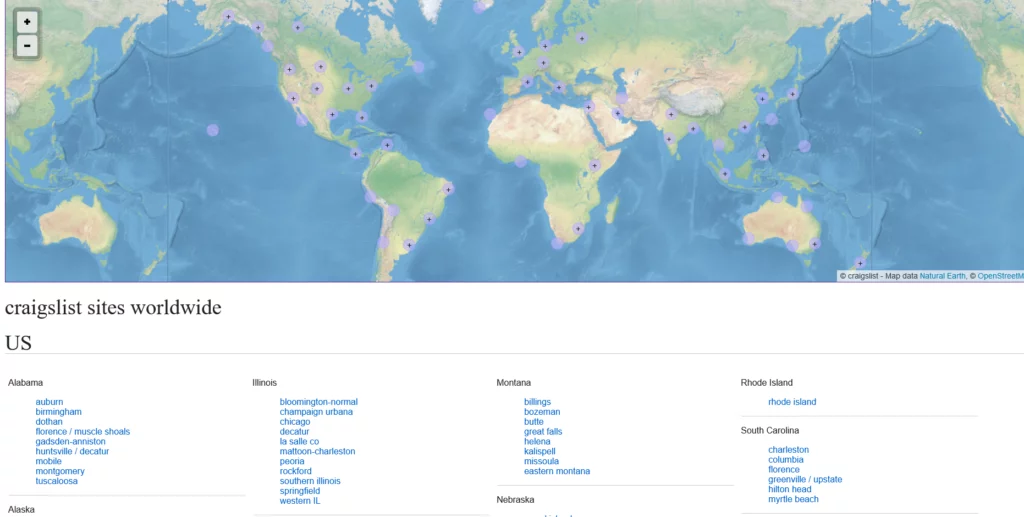
Established in 1995, Craigslist swiftly gained recognition as a go-to platform for classified advertisements. Boasting a straightforward interface and a wide range of functionalities, Craigslist serves as an expansive marketplace where users can explore diverse sections tailored for buying and selling across various categories.
The platform’s versatility shines through its extensive sections, offering a plethora of options for users. From job listings and housing rentals to community events, discussion forums, and service offerings, Craigslist provides a multifaceted space catering to an array of interests and needs.
Moreover, Craigslist features prominent categories such as electronics and technology, credit lending, adult services, items for sale, and items wanted, among others. These categories act as hubs for users seeking specific products, services, or opportunities, fostering a vibrant environment for transactions and interactions.
Craigslist’s user-driven approach encourages engagement within local and global communities. It facilitates connections between individuals seeking goods, services, or employment opportunities, contributing to a dynamic marketplace that accommodates a diverse range of interests and requirements.
This platform’s simplicity, coupled with its broad spectrum of categories and user-friendly interface, has solidified Craigslist’s position as a significant player in the online classifieds arena, empowering users to engage in various transactions and interactions in a convenient and accessible manner.
3. Macy’s
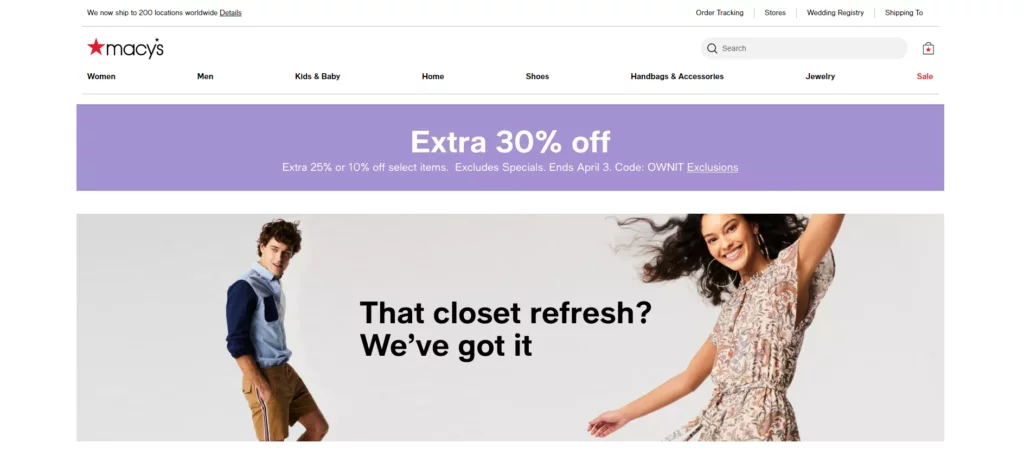
Macy’s, a stalwart in the US fashion scene since the 1990s, continues to command significant popularity and influence. Leveraging its strong legacy, Macy’s has successfully transitioned into the digital sphere, establishing a robust e-commerce platform that garners approximately 165.29 million monthly visitors. This online presence has propelled Macy’s from a national fashion brand to a globally recognized name in the realm of fashion and apparel.
Nestled within Macy’s expansive e-commerce realm are an array of categories catering to diverse consumer interests. From beauty products, accessories, cosmetics, and shoes to a wide spectrum of menswear, womenswear, home décor, and children’s clothing, Macy’s online store offers a comprehensive selection of products to meet various lifestyle needs and preferences.
Moreover, Macy’s has extended its reach into the financial sector by introducing its own credit card. This strategic move into banking and finance further diversifies the brand’s offerings, establishing Macy’s not only as a fashion powerhouse but also as a player in financial services, broadening its scope and appeal to consumers.
Macy’s remarkable journey from a US fashion brand to a globally renowned fashion and lifestyle destination highlights its adaptability and commitment to staying relevant in an ever-evolving market. Its robust online presence coupled with a wide array of offerings and entry into the financial realm solidify Macy’s position as a multifaceted brand catering to the diverse needs and aspirations of its customers.
4. BestBuy
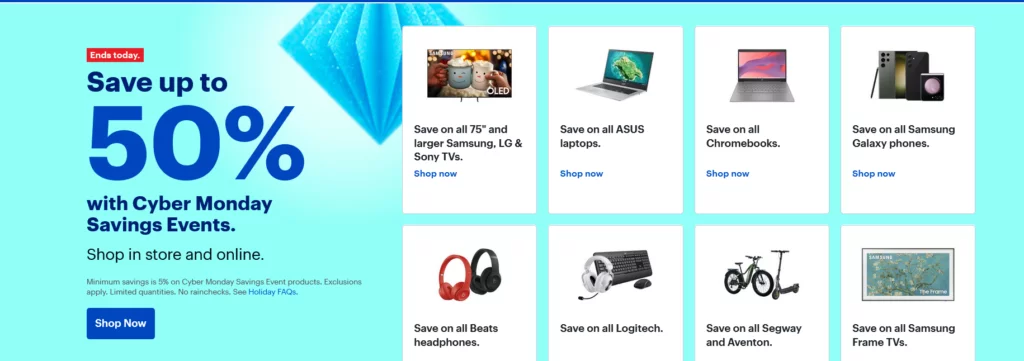
From its origins as a consumer electronics retailer, Best Buy has evolved into a multifaceted e-commerce powerhouse, diversifying its offerings to cater to a broad spectrum of consumer needs. While initially renowned for its expertise in electronics, Best Buy’s digital transformation has expanded its inventory to encompass an extensive array of products.
Within the expansive landscape of Best Buy’s e-commerce platform, customers can explore an impressive variety of categories. This includes an assortment of travel products, furniture, baby essentials, fitness gear, electronics, and household appliances. This broadening inventory signifies Best Buy’s commitment to providing a comprehensive shopping experience that extends beyond electronics into various lifestyle and household necessities.
Notably, Best Buy holds a commendable position as the third-ranked computer electronics and technology e-commerce website. Garnering an estimated figure of 192.70 million monthly visits, its robust online presence underscores its significance within the tech retail landscape, attracting a substantial and engaged audience seeking a diverse range of electronic gadgets and technological innovations.
Best Buy’s journey from a specialized electronics retailer to a versatile e-commerce platform reflects its adaptability and commitment to meeting the evolving demands of modern consumers. Its expansive offerings and formidable presence in the realm of computer electronics and technology further solidify Best Buy as a go-to destination for a wide array of products and tech-related solutions.
5. eBay
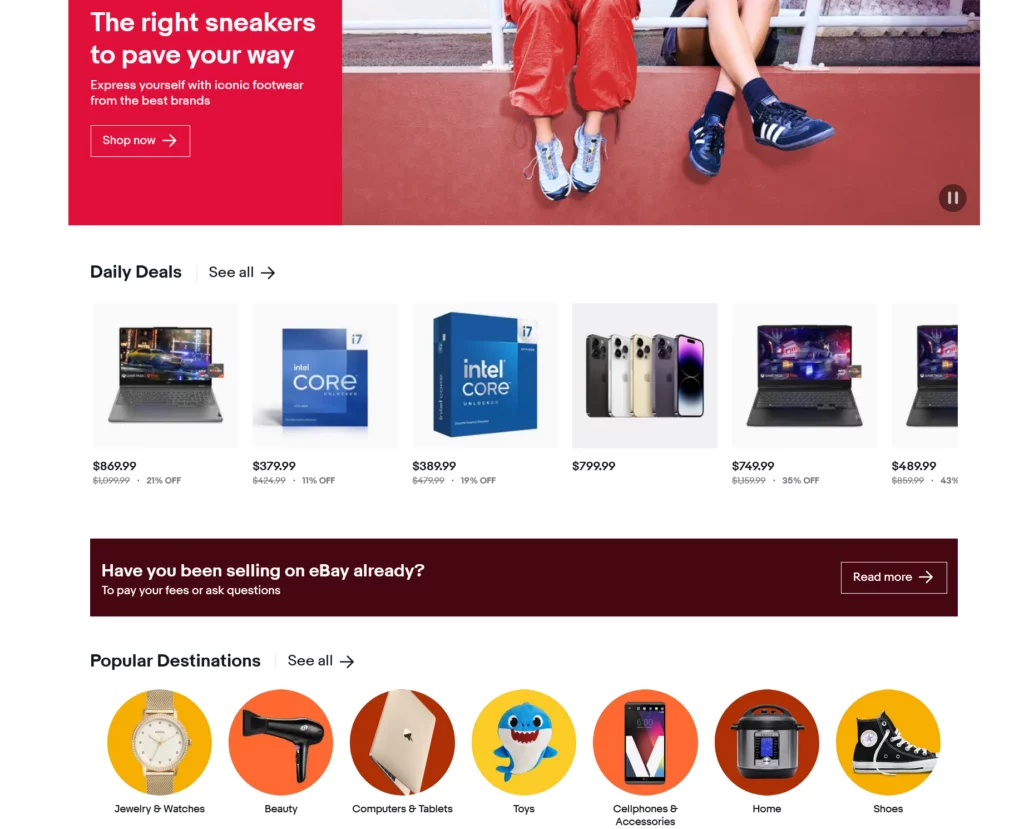
Founded in 1995 and headquartered in San Jose, California, eBay stands tall as an American multinational e-commerce giant. Over the years, eBay has made a significant global impact, delivering millions of products worldwide, showcasing a diverse inventory that caters to various consumer preferences.
At the core of eBay’s offerings lies a treasure trove of products that span a wide spectrum. From personalized items to vintage collectibles, rare finds, refurbished tools, jewelry, textiles including fabrics, curtains, and sheets, to a comprehensive range of automotive parts, eBay’s platform provides a marketplace where users can discover an eclectic mix of goods, both new and used.
What sets eBay apart is its facilitation of both Consumer-to-Consumer (C2C) and Business-to-Consumer (B2C) sales. This unique feature has contributed to its widespread popularity, as it accommodates individual sellers, collectors, and businesses, fostering a diverse and vibrant marketplace where virtually anything can be found and traded.
eBay’s prominence within the e-commerce sphere is further accentuated by its extensive product categories. From electronics and art to collectibles, auto parts, sporting goods, and beyond, eBay offers a comprehensive array of items, catering to the varied interests and needs of its global customer base.
Add plugins to your ecommerce website here.
6. Walmart

Established in 1992, Walmart has emerged as a dominant force in the American retail landscape and holds a prominent position as a leading multinational retailer in the online sphere. The company’s unwavering commitment to customer satisfaction has garnered immense appreciation, fueling its remarkable growth trajectory.
As of the present, Walmart’s staggering financial success is evidenced by its remarkable revenue generation. In the ongoing year of 2023, the company has already amassed an astounding $572.8 billion in revenue, showcasing its robust performance and substantial market presence, with the year only being halfway through.
The company’s extensive array of best-selling products reflects its diverse offerings, catering to a wide spectrum of consumer needs. From popular items like Google Chromecast and televisions to everyday essentials such as bananas, toilet paper, slow cookers, flushable wipes, storage containers, liquid laundry detergents, crayons, pillows, and paper towels, Walmart’s product lineup encompasses a wide range of categories, ensuring that customers can find a vast array of necessities and conveniences under one roof.
Walmart’s unparalleled scale, commitment to customer satisfaction, and robust financial performance consolidate its position as a juggernaut in the retail industry, underscoring its influence and significance in shaping consumer experiences and preferences globally.
7. Etsy

Founded in 2005 by Rob Kalin, Jared Tarbell, Haim Schoppik, and Chris Macguire, Etsy has established itself as a prominent American e-commerce marketplace specializing in the sale of craft supplies, vintage items, and handmade products. Headquartered in Brooklyn, New York, Etsy serves as a hub for a diverse range of product categories, spanning clothing, bags, jewelry, toys, furniture, home décor, art, and an array of craft supplies sourced from numerous suppliers.
Etsy’s platform allows sellers to ship packages weighing up to 150lbs to buyers worldwide, offering flexibility and convenience in shipping options. Among the platform’s top-selling items are success guides, particularly those guiding users on establishing and managing an Etsy shop. Additionally, handmade bags, earrings, scarves, custom mugs, home décor products, candles, and more are among the sought-after products, reflecting the marketplace’s eclectic and varied offerings.
Etsy’s impact on the U.S. economy is substantial, with its sellers contributing a remarkable $14.3 billion in 2021. This significant economic contribution highlights the platform’s role as a catalyst for entrepreneurship and commerce, nurturing a global marketplace for innovative and distinctive products and ideas.
As a global marketplace fostering creativity and providing a platform for artisans, creators, and sellers, Etsy continues to cultivate an environment where unique and exceptional products find a global audience. Its commitment to showcasing originality and craftsmanship has solidified Etsy’s position as a premier destination for individuals seeking one-of-a-kind items and creative inspiration.
8. Wish
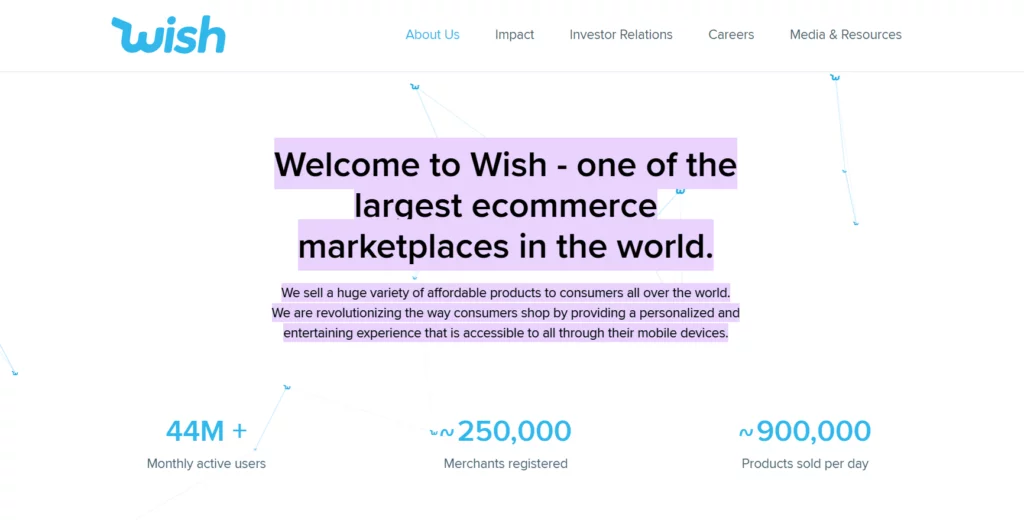
Established in San Francisco in 2010, Wish has rapidly expanded its global presence, actively engaging in commerce across over 60 countries worldwide. Renowned as one of the largest e-commerce marketplaces globally, Wish distinguishes itself by offering an extensive array of affordable products while delivering a personalized and engaging shopping experience to its vast consumer base.
Every day, Wish facilitates the sale of approximately 900,000 products, attracting more than 44 million active users and fostering relationships with over 250,000 registered merchants. The platform provides an inclusive space for merchants to showcase and sell an eclectic range of items, spanning diverse categories such as clothing, bags, baby and kids’ essentials, gadgets, mobile phone accessories, watches, jewelry, home décor items, wallets, and more.
Wish’s success is underscored by its substantial annual revenue, which amounted to an impressive $289 million in 2021. This robust financial performance reflects the platform’s efficacy in catering to the needs and preferences of its expansive user base, providing them with an assortment of products at affordable prices while ensuring an engaging and personalized shopping journey.
9. The Home Depot
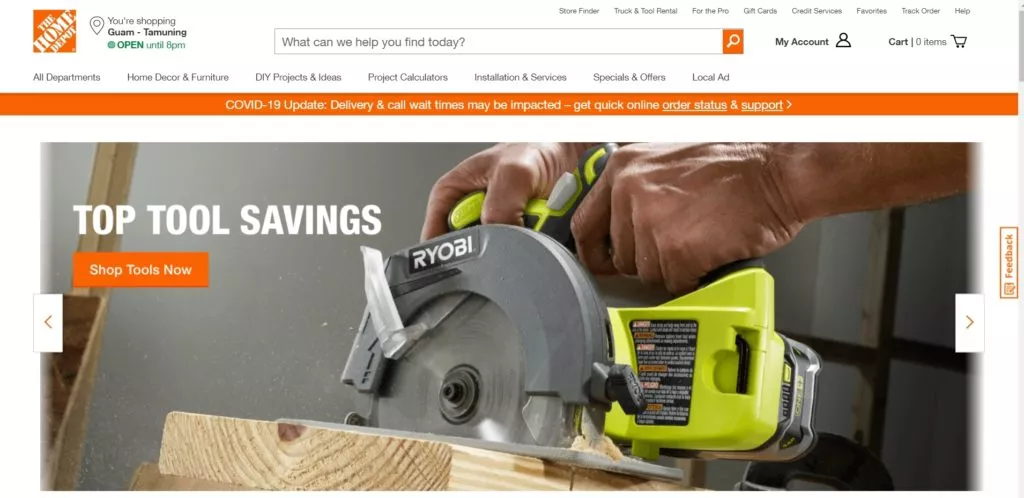
The Home Depot, a renowned American retailer specializing in home supplies, stands as a prominent hub for tools, construction products, and related services. With a vast presence spanning the United States, Canada, and Mexico, The Home Depot has cemented its position as a leading provider in the industry.
In a pivotal move back in 2005, The Home Depot ventured into the digital realm, launching its inaugural online home furnishing store. This e-commerce endeavor has evolved into a robust platform offering a staggering catalogue of over one million products tailored for diverse customer segments. From catering to the DIY enthusiasts to professional contractors and boasting the industry’s largest installation business for the Do-It-For-Me customer, The Home Depot’s e-commerce business caters to a broad spectrum of needs within the home improvement sphere.
The digital transformation proved fruitful, with The Home Depot witnessing a remarkable 14.4% surge in sales from their online channels in 2021 compared to the fiscal year 2020. This substantial growth in online sales amounted to a staggering $151.2 billion in revenue for the year 2021, underscoring the company’s prowess in adapting to the evolving market trends and meeting the demands of an increasingly digital-savvy consumer base.
The Home Depot’s strategic foray into online retailing, coupled with its expansive range of products and services, has not only strengthened its market position but also positioned the company as a trailblazer in the home improvement industry. Its commitment to catering to various customer segments and delivering exceptional value through its online channels has contributed significantly to its substantial sales growth and sustained success.
Conclusion:
Online shopping gives consumers the more comfortable options they’re looking for when it comes to buying. Customers can shop online from the convenience of their home and purchase anything they want. Due to the rise of online shopping VPN technology providers, you do not have to worry about security in addition to its evident convenience. Your internet connection is protected, preventing Wi-Fi data theft.
FAQs on Ecommerce Websites:
Which online store has the finest customer service?
The top 4 e-commerce websites in terms of page views, visit length, and bounce rate are Amazon, eBay, Rakuten, and AliExpress.
What is the top online retailer?
With an anticipated 2.73 billion monthly visits and a projected global sales of over $469 billion in 2021, Amazon.com is the top online retailer. With an estimated 855.82 million monthly visitors, eBay follows next.Walmart.com, which has 468.96 million monthly visitors, comes next.
What is the world’s biggest e-commerce website?
With an anticipated 2.73 billion monthly visitors and a projected global turnover of over $469 billion in 2021, Amazon will be the most popular e-commerce site on the planet.
Who is the top online retailer?
With an expected 2.73 billion monthly visits and a global revenue of more than $469 billion in 2021, Amazon is the largest online retailer in the world.



